Dragonfly
From Wikipedia, the free encyclopedia
A
dragonfly is an
insect belonging to the order
Odonata,
infraorder Anisoptera (from
Greek ἄνισος
anisos "uneven" and πτερόν
pteron, "wing", because the
hindwing is broader than the
forewing). Adult dragonflies are characterized by large,
multifaceted eyes, two pairs of strong, transparent
wings, sometimes with coloured patches, and an elongated body. Dragonflies can be mistaken for the related group,
damselflies
(Zygoptera), which are similar in structure, though usually lighter in
build; however, the wings of most dragonflies are held flat and away
from the body, while damselflies hold the wings folded at rest, along or
above the abdomen. Dragonflies are agile fliers, while damselflies have
a weaker, fluttery flight. Many dragonflies have brilliant
iridescent or metallic colours produced by
structural coloration, making them conspicuous in flight. An adult dragonfly’s
compound eyes have nearly 24,000
ommatidia each.
Fossils of very large dragonfly ancestors in the
Protodonata are found from 325 million years ago (Mya) in
Upper Carboniferous rocks; these had wingspans up to about 750 mm (30 in). About
3000 species of Anisoptera are in the world today. Most are
tropical, with fewer species in
temperate regions.
Dragonflies are
predators, both in their aquatic
larval stage, when they are known as
nymphs
or naiads, and as adults. Several years of their lives are spent as
nymphs living in fresh water; the adults may be on the wing for just a
few days or weeks. They are fast, agile fliers, sometimes migrating
across oceans, and are often found near water. They have a uniquely
complex mode of reproduction involving indirect insemination, delayed
fertilization, and sperm competition. During mating, the male grasps the
female at the back of the head or on the prothorax, and the female
curls her abdomen under her body to pick up sperm from the male's
secondary genitalia at the front of his abdomen, forming the "heart" or
"wheel" posture.
Loss of
wetland
habitat threatens dragonfly populations around the world. Dragonflies
are represented in human culture on artifacts such as pottery, rock
paintings, and
Art Nouveau
jewellery. They are used in traditional medicine in Japan and China,
and caught for food in Indonesia. They are symbols of courage, strength,
and happiness in Japan, but seen as sinister in European folklore.
Their bright colours and agile flight are admired in the poetry of
Alfred, Lord Tennyson and the prose of
H. E. Bates.
Phylogeny
Dragonflies and their relatives are an ancient group. The oldest fossils are of the
Protodonata from the 325 Mya Upper
Carboniferous of Europe, a group that included the largest insect that ever lived,
Meganeuropsis permiana from the early
Permian, with a wingspan around 750 mm (30 in);
[2] their fossil record ends with the
Permian–Triassic extinction event (about 247 Mya). The
Protoanisoptera,
another ancestral group which lacks certain wing vein characters found
in modern Odonata, lived from the Early to Late Permian age until the
end Permian event, and are known from fossil wings from current day
United States, Russia, and Australia, suggesting they might have been
cosmopolitan in distribution. The forerunners of modern Odonata are
included in a clade called the Panodonata, which include the basal
Zygoptera (damselflies) and the Anisoptera (true dragonflies)
[3] Today there are some 3000 species extant around the world.
[4][5]
The relationships of anisopteran families are not fully resolved as of 2013, but all the families are
monophyletic except the
Corduliidae; the
Gomphidae are a
sister taxon to all other Anisoptera, the
Austropetaliidae are sister to the
Aeshnoidea, and the
Chlorogomphidae are sister to a
clade that includes the
Synthemistidae and
Libellulidae.
[6] On the
cladogram, dashed lines indicate unresolved relationships; English names are given (in parentheses):
Distribution and diversity
About 3012 species of dragonflies were known in 2010; these are classified into
348 genera in
11 families.
The distribution of diversity within the biogeographical regions are
summarised below (the world numbers are not ordinary totals, as overlaps
in species occur).
[7]
Dragonflies are found on every continent except Antarctica. In
contrast to the damselflies (Zygoptera), which tend to have restricted
distributions, some genera and species are found across continents. For
example, the blue-eyed darner
Rhionaeschna multicolor is found all across North America, and in Central America;
[8] emperors
Anax are found throughout the Americas from as far north as Newfoundland to as far south as Bahia Blanca in Argentina,
[9] across Europe to central Asia, North Africa, and the Middle East.
[10] The globe skimmer
Pantala flavescens
is probably the most widespread dragonfly species in the world; it is
cosmopolitan, occurring on all continents in the warmer regions. Most
Anisoptera species are tropical, with far fewer species in temperate
regions.
Dragonflies including libellulids and aeshnids are found in desert pools, for example in the
Mojave Desert,
where they are active in shade temperatures between 18 and 45 °C (64.4
to 113 °F); these insects were able to survive body temperatures above
the thermal death point of insects of the same species found in cooler
places.
[12]
Dragonflies can be found from sea level up to the mountains, decreasing in species diversity with altitude.
[13] Their altitudinal limit is about 3700 m, represented by a species of
Aeshna in the
Pamirs.
[14]
Dragonflies become scarce at higher latitudes. They are not native to
Iceland, but individuals are occasionally swept in by strong winds, including a
Hemianax ephippiger native to North Africa, and an unidentified darter species.
[15] In
Kamchatka, only a few species of dragonfly including the treeline emerald
Somatochlora arctica and some aeshnids such as
Aeshna subarctica are found, possibly because of the low temperature of the lakes there.
[16] The treeline emerald is also found in northern
Alaska, within the
Arctic Circle, making it the most northerly of all dragonflies.
[17]
General description
Dragonflies (suborder Anisoptera) are heavy-bodied, strong-flying
insects that hold their wings horizontally both in flight and at rest.
By contrast,
damselflies
(suborder Zygoptera) have slender bodies and fly more weakly; most
species fold their wings over the abdomen when stationary, and the eyes
are well separated on the sides of the head.
[7][18]
An adult dragonfly has three distinct segments, the head, thorax, and abdomen as in all insects. It has a
chitinous exoskeleton of hard plates held together with flexible membranes. The head is large with very short
antennae. It is dominated by the two
compound eyes, which cover most of its surface. The compound eyes are made up of
ommatidia, the numbers being greater in the larger species.
Aeshna interrupta has 22650 ommatidia of two varying sizes, 4500 being large. The facets facing downward tend to be smaller.
Petalura gigantea has 23890 ommatidia of just one size. These facets provide complete vision in the frontal hemisphere of the dragonfly.
[19] The compound eyes meet at the top of the head (except in the Petaluridae and Gomphidae, as also in the genus
Epiophlebia). Also, they have three
simple eyes or ocelli. The mouthparts are adapted for biting with a toothed jaw; the flap-like
labrum, at the front of the mouth, can be shot rapidly forward to catch
prey.
[20]
The head has a system for locking it in place that consists of muscles
and small hairs on the back of the head that grip structures on the
front of the first thoracic segment. This arrester system is unique to
the Odonata and is activated when feeding and during tandem flight.
[7]
The thorax consists of three segments as in all insects. The
prothorax is small and is flattened dorsally into a shield-like disc which has two transverse ridges. The
mesothorax and
metathorax
are fused into a rigid, box-like structure with internal bracing, and
provides a robust attachment for the powerful wing muscles inside it.
[22]
The thorax bears two pairs of wings and three pairs of legs. The wings
are long, veined, and membranous, narrower at the tip and wider at the
base. The hindwings are broader than the forewings and the venation is
different at the base.
[23] The veins carry
haemolymph
which is pumped in at the time of emergence from the nymphal stage to
expand the wings. The leading edge of each wing has a node where other
veins join the marginal vein, and the wing is able to flex at this
point. In most large species of dragonflies, the wings of females are
shorter and broader than those of males.
The legs are rarely used for walking, but are used to catch and hold
prey, for perching, and for climbing on plants. Each has two short basal
joints, two long joints, and a three-jointed foot, armed with a pair of
claws. The long leg joints bear rows of spines, and in males, one row
of spines on each front leg is modified to form an "eyebrush", for
cleaning the surface of the compound eye.
[22]
The abdomen is long and slender and consists of 10 segments and a
terminal appendage-bearing segment. The second and third segments are
enlarged, and in males, a cleft on the underside of the second segment
contains a pair of claspers and the penis. The spermaries open on the
9th segment. In females, the genital opening is on the underside of the
eighth segment and is covered by a simple flap or an
ovipositor, depending on species and the method of egg-laying.
[22]
Dragonfly nymphs vary in form with species and are loosely classed into claspers, sprawlers, hiders, and burrowers.
[7]
The first instar is known as a prolarva, a relatively inactive stage
from which it quickly moults into the more active nymphal form.
[24]
The general body plan is similar to that of an adult, but the nymph
lacks wings and reproductive organs. The lower jaw has a huge,
extensible
labium,
armed with hooks and spines, which is used for catching prey. This
labium is folded under the body at rest and struck out at great speed by
hydraulic pressure created by the abdominal muscles.
[7] Whereas damselfly nymphs have three feathery external
gills,
dragonfly nymphs have internal gills, located around the fourth and
fifth abdominal segments. Water is pumped in and out of the abdomen
through an opening at the tip. The naiads of some clubtails (
Gomphidae)
that burrow into the sediment, have a snorkel-like tube at the end of
the abdomen enabling them to draw in clean water while they are buried
in mud. Naiads can forcefully expel a jet of water to propel themselves
with great rapidity.
[25]
Coloration
Many adult dragonflies have brilliant
iridescent or metallic colours produced by
structural coloration, making them conspicuous in flight. Their overall
coloration
is often a combination of yellow, red, brown, and black pigments, with
structural colours. Blues are typically created by microstructures in
the cuticle that reflect blue light. Greens often combine a structural
blue with a yellow pigment. Freshly emerged adults, known as tenerals,
are often pale-coloured and obtain their typical colours after a few
days,
[23]
some have their bodies covered with a pale blue, waxy powderiness
called pruinosity; it wears off when scraped during mating, leaving
darker areas.
Noniridescent structural blue occurs in the green darner,
Anax junius; the female (below) lacks blue.
Some dragonflies, such as the green darner,
Anax junius, have a noniridescent blue which is produced structurally by scatter from arrays of tiny spheres in the
endoplasmic reticulum of epidermal cells underneath the cuticle.
[27]
The wings of dragonflies are generally clear, apart from the dark
veins and pterostigmata. In the chasers (Libellulidae), however, many
genera have areas of colour on the wings: for example, groundlings (
Brachythemis) have brown bands on all four wings, while some scarlets (
Crocothemis) and dropwings (
Trithemis) have bright orange patches at the wing bases. Some aeshnids such as the brown hawker (
Aeshna grandis) have translucent, pale yellow wings.
Dragonfly nymphs are usually a well-
camouflaged blend of dull brown, green, and grey.
[25]
Biology
Ecology
Dragonflies
and damselflies are predatory both in the aquatic nymphal and adult
stages. Nymphs feed on a range of freshwater invertebrates and larger
ones can prey on
tadpoles and small
fish.
Adults capture insect prey in the air, making use of their acute vision
and highly controlled flight. The mating system of dragonflies is
complex and they are among the few insect groups that have a system of
indirect sperm transfer along with sperm storage, delayed fertilization,
and sperm competition.
Adult males vigorously defend territories near water; these areas
provide suitable habitat for the larvae to develop, and for females to
lay their eggs. Swarms of feeding adults aggregate to prey on swarming
prey such as emerging flying ants or termites.
Dragonflies as a group occupy a considerable variety of habitats, but
many species, and some families, have their own specific environmental
requirements.
Some species prefer flowing waters, while others prefer standing water.
For example, the Gomphidae (clubtails) live in running water, and the
Libellulidae (skimmers) live in still water.
Some species are found in temporary water pools and are capable of
tolerating changes in water level, desiccation, and the resulting
variations in temperature, but some genera such as
Sympetrum
(darters) have eggs and larvae that can resist drought and are
stimulated to grow rapidly in warm, shallow pools, also often benefiting
from the absence of predators there.
Vegetation and its characteristics including submerged, floating,
emergent, or waterside are also important. Adults may require emergent
or waterside plants to use as perches; others may need specific
submerged or floating plants on which to lay eggs. Requirements may be
highly specific, as in
Aeshna viridis (green hawker), which lives in swamps with the water-soldier,
Stratiotes aloides. The chemistry of the water, including its trophic status (degree of enrichment with nutrients) and
pH can also affect its use by dragonflies. Most species need moderate conditions, not too
eutrophic, not too acid; a few species such as
Sympetrum danae (black darter) and
Libellula quadrimaculata (four-spotted chaser) prefer acidic waters such as peat bogs, while others such as
Libellula fulva (scarce chaser) need slow-moving, eutrophic waters with reeds or similar waterside plants.
[33]
Behaviour
Many dragonflies, particularly males, are
territorial.
Some defend a territory against others of their own species, some
against other species of dragonfly and a few against insects in
unrelated groups. A particular perch may give a dragonfly a good view
over an insect-rich feeding ground, and the
blue dasher (
Pachydiplax longipennis) jostles other dragonflies to maintain the right to alight there.
Defending a breeding territory is fairly common among male
dragonflies, especially among species that congregate around ponds in
large numbers. The territory contains desirable features such as a
sunlit stretch of shallow water, a special plant species, or a
particular
substrate
necessary for egg-laying. The territory may be small or large,
depending on its quality, the time of day, and the number of
competitors, and may be held for a few minutes or several hours. Some
dragonflies signal ownership with striking colours on the face, abdomen,
legs, or wings. The
common whitetail (
Plathemis lydia)
dashes towards an intruder holding its white abdomen aloft like a flag.
Other dragonflies engage in aerial dogfights or high-speed chases. A
female must mate with the territory holder before laying her eggs. There is also
conflict
between the males and females. Females may sometimes be harassed by
males to the extent that it affects their normal activities including
foraging and in some dimorphic species females have evolved multiple
forms with some forms appearing deceptively like males.
[35] In some species females have evolved behavioural responses such as feigning death to escape the attention of males.
[36]
Reproduction
Mating in dragonflies is a complex, precisely choreographed process.
First, the male has to attract a female to his territory, continually
driving off rival males. When he is ready to mate, he transfers a packet
of sperm from his primary genital opening on segment 9, near the end of
his abdomen, to his secondary genitalia on segments 2–3, near the base
of his abdomen. The male then grasps the female by the head with the
claspers at the end of his abdomen; the structure of the claspers varies
between species, and may help to prevent interspecific mating.
[37]
The pair flies in tandem with the male in front, typically perching on a
twig or plant stem. The female then curls her abdomen downwards and
forwards under her body to pick up the sperm from the male's secondary
genitalia, while the male uses his "tail" claspers to grip the female
behind the head: this distinctive posture is called the "heart" or
"wheel";
[38] the pair may also be described as being "in cop".
Egg-laying (ovipositing) involves not only the female darting over
floating or waterside vegetation to deposit eggs on a suitable
substrate, but also the male hovering above her or continuing to clasp
her and flying in tandem. The male attempts to prevent rivals from
removing his sperm and inserting their own,
[40] something made possible by delayed fertilisation
[38] and driven by
sexual selection.
[37]
If successful, a rival male uses his penis to compress or scrape out
the sperm inserted previously; this activity takes up much of the time
that a copulating pair remains in the heart posture.
Flying in tandem has the advantage that less effort is needed by the
female for flight and more can be expended on egg-laying, and when the
female submerges to deposit eggs, the male may help to pull her out of
the water.
[40]
Egg-laying takes two different forms depending on the species. The
female in some families has a sharp-edged ovipositor with which she
slits open a stem or leaf of a plant on or near the water, so she can
push her eggs inside. In other families such as clubtails (Gomphidae),
cruisers (Macromiidae), emeralds (Corduliidae), and skimmers
(Libellulidae), the female lays eggs by tapping the surface of the water
repeatedly with her abdomen, by shaking the eggs out of her abdomen as
she flies along, or by placing the eggs on vegetation.
In a few species, the eggs are laid on emergent plants above the water,
and development is delayed until these have withered and become
immersed.
[25]
Life cycle
Dragonflies are
hemimetabolous insects; they do not have a
pupal stage and undergo an incomplete
metamorphosis with a series of nymphal stages from which the adult emerges.
[41]
Eggs laid inside plant tissues are usually shaped like grains of rice,
while other eggs are the size of a pinhead, ellipsoidal, or nearly
spherical. A clutch may have as many as 1500 eggs, and they take about a
week to hatch into aquatic
nymphs or naiads which moult between six and 15 times (depending on species) as they grow.
[7]
Most of a dragonfly's life is spent as a nymph, beneath the water's
surface. The nymph extends its hinged labium (a toothed mouthpart
similar to a lower mandible which is sometimes termed as a "mask" as it
is normally folded and held before the face) which can extend forward
and retract rapidly to capture prey such as
mosquito larvae,
tadpoles, and small fish.
[41] They breathe through gills in their
rectum, and can rapidly propel themselves by suddenly expelling water through the anus.
[42] Some naiads, such as the later stages of
Antipodophlebia asthenes, hunt on land.
[43]
Parts of a dragonfly nymph including the labial "mask"
The larval stage of dragonflies lasts up to five years in large
species, and between two months and three years in smaller species. When
the naiad is ready to metamorphose into an adult, it stops feeding and
makes its way to the surface, generally at night. It remains stationary
with its head out of the water, while its respiration system adapts to
breathing air, then climbs up a
reed or other emergent plant, and moults (
ecdysis).
Anchoring itself firmly in a vertical position with its claws, its skin
begins to split at a weak spot behind the head. The adult dragonfly
crawls out of its larval skin, the
exuvia,
arching backwards when all but the tip of its abdomen is free, to allow
its exoskeleton to harden. Curling back upwards, it completes its
emergence, swallowing air, which plumps out its body, and pumping
haemolymph into its wings, which causes them to expand to their full extent.
Dragonflies in temperate areas can be categorized into two groups, an
early group and a later one. In any one area, individuals of a
particular "spring species" emerge within a few days of each other. The
springtime darner (
Basiaeschna janata),
for example, is suddenly very common in the spring, but has disappeared
a few weeks later and is not seen again until the following year. By
contrast, a "summer species" emerges over a period of weeks or months,
later in the year. They may be seen on the wing for several months, but
this may represent a whole series of individuals, with new adults
hatching out as earlier ones complete their short lifespans.
Sex ratios
The
sex ratio
of male to female dragonflies varies both temporally and spatially.
Adult dragonflies have a high male-biased ratio at breeding habitats.
The male-bias ratio has contributed partially to the females using
different habitats to avoid male harassment. As seen in Hine’s emerald
dragonfly (
Somatochlora hineana),
male populations use wetland habitats, while females use dry meadows
and marginal breeding habitats, only migrating to the wetlands to lay
their eggs or to find mating partners. Unwanted mating is energetically
costly for females because it affects the amount of time that they are
able to spend foraging.
[46]
Brown hawker,
Aeshna grandis in flight: The hindwings are about 90°
out of phase with the forewings at this instant, suggesting fast flight.
Flight
Dragonflies are powerful and agile fliers, capable of
migrating
across oceans, moving in any direction, and changing direction
suddenly. In flight, the adult dragonfly can propel itself in six
directions: upward, downward, forward, back, to left and to right.
[47] They have four different styles of flight:
[48] A number of flying modes are used that include counter-stroking, with forewings beating 180°
out of phase
with the hindwings, is used for hovering and slow flight. This style is
efficient and generates a large amount of lift; phased-stroking, with
the hindwings beating 90° ahead of the forewings, is used for fast
flight. This style creates more thrust, but less lift than
counter-stroking; synchronised-stroking, with forewings and hindwings
beating together, is used when changing direction rapidly, as it
maximises thrust; and gliding, with the wings held out, is used in three
situations: free gliding, for a few seconds in between bursts of
powered flight; gliding in the updraft at the crest of a hill,
effectively hovering by falling at the same speed as the updraft; and in
certain dragonflies such as darters, when "in cop" with a male, the
female sometimes simply glides while the male pulls the pair along by
beating his wings.
[48]
Southern hawker,
Aeshna cyanea: its wings at this instant are synchronised for agile flight.
The wings are
powered directly,
with the flight muscles attached to the wing bases. Dragonflies have a
high power/weight ratio, and have been documented accelerating at 4 G
linearly and 9 G in sharp turns while pursuing prey.
[48]
Dragonflies generate lift in at least four ways at different times, including classical
lift like an aircraft
wing;
supercritical lift with the wing above the critical angle, generating
high lift and using very short strokes to avoid stalling; creating
vortices; and vortex shedding. Some families appear to use special
mechanisms, as for example the Libellulidae which take off rapidly,
their wings beginning pointed far forward and twisted almost vertically.
Dragonfly wings behave highly dynamically during flight, flexing and
twisting during each beat. Among the variables are wing curvature,
length and speed of stroke,
angle of attack, forward/back position of wing, and phase relative to the other wings.
[48]
Flight speed
Old and unreliable claims are made that dragonflies such as the
southern giant darner can fly up to 60 miles per hour (97 km/h).
[49] However, the greatest reliable flight speed records are for other types of insects.
[50]
In general, large dragonflies like the hawkers have a maximum speed of
10–15 metres per second (22–34 mph) with average cruising speed of about
4.5 metres per second (10 mph).
[51] Dragonflies can fly at 100 body-lengths per second, and three lengths per second backwards.
[20]
Motion camouflage
In high-speed territorial battles between male
Australian emperors (
Hemianax papuensis),
the fighting dragonflies adjust their flight paths to appear stationary
to their rivals, minimizing the chance of being detected as they
approach.
[a][52][53]
To achieve the effect, the attacking dragonfly flies towards his rival,
choosing his path to remain on a line between the rival and the start
of his attack path. The attacker thus
looms larger as he closes on the rival, but does not otherwise appear to move. Researchers found that six of 15 encounters involved
motion camouflage.
[54]
Temperature control
The flight muscles need to be kept at a suitable temperature for the dragonfly to be able to fly. Being
cold-blooded,
they can raise their temperature by basking in the sun. Early in the
morning, they may choose to perch in a vertical position with the wings
outstretched, while in the middle of the day, a horizontal stance may be
chosen. Another method of warming up used by some larger dragonflies is
wing-whirring, a rapid vibration of the wings that causes heat to be
generated in the flight muscles. The
green darner (
Anax junius) is known for its long-distance migrations, and often resorts to wing-whirring before dawn to enable it to make an early start.
Becoming too hot is another hazard, and a sunny or shady position for
perching can be selected according to the ambient temperature. Some
species have dark patches on the wings which can provide shade for the
body, and a few use the
obelisk posture to avoid overheating. This behaviour involves doing a "
handstand",
perching with the body raised and the abdomen pointing towards the sun,
thus minimising the amount of solar radiation received. On a hot day,
dragonflies sometimes adjust their body temperature by skimming over a
water surface and briefly touching it, often three times in quick
succession. This may also help to avoid desiccation.
Feeding
Adult dragonflies hunt on the wing using their exceptionally acute eyesight and strong, agile flight.
[38] They are almost exclusively carnivorous, eating a wide variety of insects ranging from small
midges and
mosquitoes to
butterflies,
moths,
damselflies, and smaller dragonflies.
[51]
A large prey item is subdued by being bitten on the head and is carried
by the legs to a perch. Here, the wings are discarded and the prey
usually ingested head first. A dragonfly may consume as much as a fifth of its body weight in prey per day.
The larvae are voracious predators, eating most living things that are smaller than they are. Their staple diet is mostly
bloodworms and other insect larvae, but they also feed on
tadpoles and small fish.
[51] A few species, especially those that live in temporary waters, are likely to leave water. Nymphs of
Cordulegaster bidentata sometimes hunt small arthropods on the ground at night.
[7]
Predators and parasites
Although dragonflies are swift and agile fliers, some predators are
fast enough to catch them. These include falcons such as the
American kestrel, the
merlin, and the
hobby;
[59] nighthawks,
swifts,
flycatchers and
swallows
also take some adults; some species of wasps, too, prey on dragonflies,
using them to provision their nests, laying an egg on each captured
insect. In the water, various species of ducks and herons eat dragonfly
larvae and they are also preyed on by newts, frogs, fish, and water spiders.
Amur falcons, which migrate over the Indian Ocean at a period that coincides with the migration of the globe skimmer dragonfly,
Pantala flavescens, may actually be feeding on them while on the wing.
[61]
Dragonflies are affected by three major groups of
parasites: water mites, gregarine protozoa, and
trematode flatworms (flukes). Water mites,
Hydracarina, can kill smaller dragonfly larvae, and may also be seen on adults.
[62] Gregarines infect the gut and may cause blockage and secondary infection.
[63] Trematodes are parasites of
vertebrates such as frogs, with complex
life cycles often involving a period as a stage called a
cercaria
in a secondary host, a snail. Dragonfly nymphs may swallow cercariae,
or these may tunnel through a nymph's body wall; they then enter the gut
and form a cyst or metacercaria, which remains in the nymph for the
whole of its development. If the nymph is eaten by a frog, the amphibian
becomes infected by the adult or fluke stage of the trematode.
[64]
Dragonflies and humans
Conservation
Most
odonatologists live in temperate areas and the dragonflies of North
America and Europe have been the subject of much research. However, the
majority of species live in tropical areas and have been little studied.
With the destruction of rainforest habitats, many of these species are
in danger of becoming extinct before they have even been named. The
greatest cause of decline is forest clearance with the consequent drying
up of streams and pools which become clogged with silt. The damming of
rivers for hydroelectric schemes and the drainage of low-lying land has
reduced suitable habitat, as has pollution and the introduction of alien
species.
[65]
In 1997, the
International Union for Conservation of Nature
set up a status survey and conservation action plan for dragonflies.
This proposes the establishment of protected areas around the world and
the management of these areas to provide suitable habitat for
dragonflies. Outside these areas, encouragement should be given to
modify forestry, agricultural, and industrial practices to enhance
conservation. At the same time, more research into dragonflies needs to
be done, consideration should be given to pollution control and the
public should be educated about the importance of
biodiversity.
[65]
Habitat degradation has reduced dragonfly populations across the world, for example in Japan.
[66]
Over 60% of Japan's wetlands were lost in the 20th century, so its
dragonflies now depend largely on rice fields, ponds, and creeks.
Dragonflies feed on pest insects in rice, acting as a natural pest
control.
[67][68] Dragonflies are steadily declining in Africa, and represent a conservation priority.
[69]
The dragonfly's long lifespan and low population density makes it
vulnerable to disturbance, such as from collisions with vehicles on
roads built near wetlands. Species that fly low and slow may be most at
risk.
[70]
Dragonflies are attracted to shiny surfaces that produce polarization
which they can mistake for water, and they have been known to aggregate
close to polished gravestones, solar panels, automobiles, and other
such structures on which they attempt to lay eggs. These can have a
local impact on dragonfly populations; methods of reducing the
attractiveness of structures such as solar panels are under
experimentation.
[71][72]
In culture
A blue-glazed
faience dragonfly
amulet was found by
Flinders Petrie at Lahun, from the Late
Middle Kingdom of
ancient Egypt.
[73]
For some
Native American tribes, dragonflies represent swiftness and activity; for the
Navajo, they symbolize pure water. They are a common motif in
Zuni pottery; stylized as a double-barred cross, they appear in
Hopi rock art and on
Pueblo necklaces.
[74]:20–26 They have been used in traditional medicine in Japan and China. In
Indonesia, adults are caught on poles made sticky with
birdlime, then fried in oil as a delicacy.
Tiffany dragonfly pendant lamp
In the United States, dragonflies and damselflies are sought out as a
hobby similar to birding and butterflying, known as oding, from the
Latin name of the dragonfly order, Odonata. Oding is especially popular
in Texas, where 225 different species of odonates have been observed.
With care, and with dry fingers, dragonflies can be handled and released
by oders, as can be done with butterflies, though it is not encouraged.
[76]
Images of dragonflies are common in
Art Nouveau, especially in jewellery designs.
[77] They have also been used as a decorative motif on fabrics and home furnishings.
[78] Douglas, a British motorcycle manufacturer based in Bristol, named its innovatively designed postwar 350-cc flat-twin model the
Dragonfly.
[79]
Among the classical
names of Japan are
Akitsukuni (秋津国),
Akitsushima (秋津島),
Toyo-akitsushima (豊秋津島).
Akitu or
akidu are archaic or dialectal Japanese words for dragonfly, so one interpretation of
Akitsushima is "Dragonfly Island".
[80] This is attributed to a legend in which Japan's mythical founder,
Emperor Jinmu, was bitten by a
mosquito, which was then eaten by a dragonfly.
[81][82]
As a seasonal symbol in Japan, the dragonfly is associated with autumn.
[83]
More generally, dragonflies are symbols of courage, strength, and
happiness, and they often appear in art and literature, especially
haiku.
Japanese children catch large dragonflies as a game, using a hair with a
small pebble tied to each end, which they throw into the air. The
dragonfly mistakes the pebbles for prey, gets tangled in the hair, and
is dragged to the ground by the weight.
[74]:38
Accurately drawn dragonflies by
Moses Harris, 1780: At top left, the brown hawker,
Aeshna grandis (described by
Linnaeus, 1758); the nymph at lower left is shown with the "mask" extended.
In Europe, dragonflies have often been seen as sinister. Some English vernacular names, such as "horse-stinger",
[84] "
devil's darning needle", and "ear cutter", link them with evil or injury.
Swedish folklore holds that the devil uses dragonflies to weigh people's souls.
[74]:25–27 The
Norwegian name for dragonflies is
Øyenstikker ("eye-poker"), and in
Portugal, they are sometimes called
tira-olhos ("eyes-snatcher"). They are often associated with
snakes, as in the
Welsh name
gwas-y-neidr, "
adder's servant". The
Southern United States
term "snake doctor" refers to a folk belief that dragonflies follow
snakes around and stitch them back together if they are injured.
[86]
The watercolourist
Moses Harris (1731–1785), known for his
The Aurelian or natural history of English insects (1766), published in 1780, the first scientific descriptions of several Odonata including the banded demoiselle,
Calopteryx splendens. He was the first English artist to make illustrations of dragonflies accurate enough to be identified to species (
Aeshna grandis
at top left of plate illustrated), though his rough drawing of a larva
(at lower left) with the mask extended appears to be plagiarised.
[b][87]
In poetry and literature
Japanese
tsuba with a dragonfly, 1931:
Shibuichi with gold and silver, Walters Art Museum
Lafcadio Hearn wrote in his 1901 book
A Japanese Miscellany that Japanese poets had created dragonfly
haiku "almost as numerous as are the dragonflies themselves in the early autumn."
[88] The poet
Matsuo Bashō (1644–1694) wrote
haiku
such as "Crimson pepper pod / add two pairs of wings, and look /
darting dragonfly", relating the autumn season to the dragonfly.
[89] Hori Bakusui (1718–1783) similarly wrote "Dyed he is with the / Colour of autumnal days, / O red dragonfly."
[88]
The poet
Alfred, Lord Tennyson, described a dragonfly splitting its old skin and emerging shining metallic blue like "
sapphire mail"
in his 1842 poem "The Two Voices", with the lines "An inner impulse
rent the veil / Of his old husk: from head to tail / Came out clear
plates of sapphire mail."
[90]
The novelist
H. E. Bates described the rapid, agile flight of dragonflies in his 1937 nonfiction book
[91] Down the River:
I saw, once, an endless procession, just over an area of
water-lilies, of small sapphire dragonflies, a continuous play of blue
gauze over the snowy flowers above the sun-glassy water. It was all
confined, in true dragonfly fashion, to one small space. It was a
continuous turning and returning, an endless darting, poising, striking
and hovering, so swift that it was often lost in sunlight.[93]
Notes



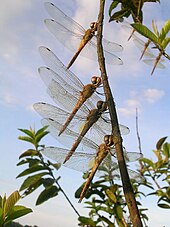



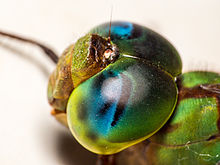

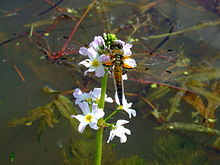


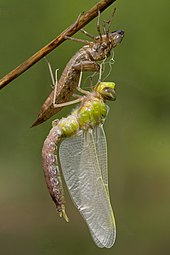



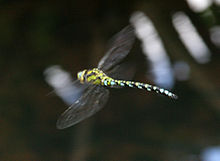


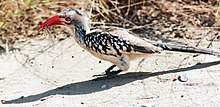

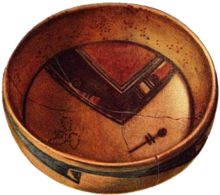
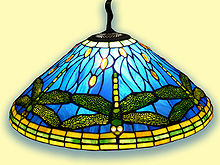
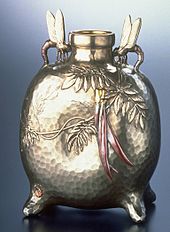


No comments:
Post a Comment